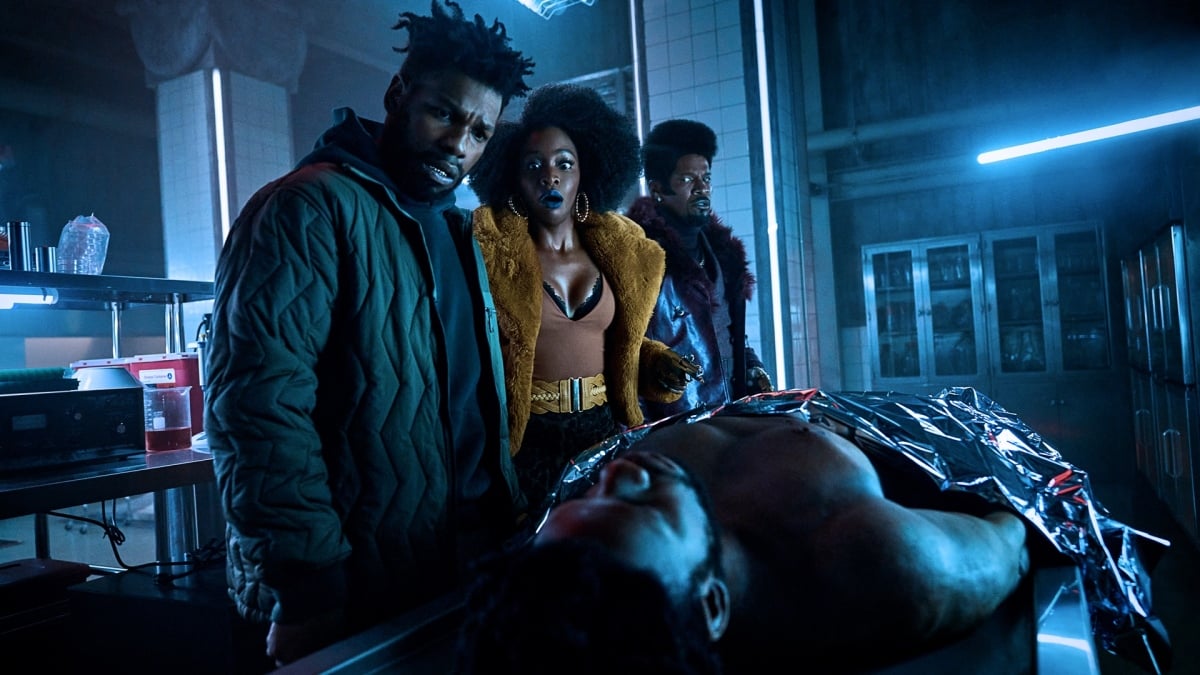Entertainment
‘They Cloned Tyrone’ ending explained

John Boyega does a bang-up job in They Cloned Tyrone — Juel Taylor’s combination Blaxploitation throwback/conspiracy comedy-drama — but he’s also the on-screen avatar for its most indulgent flaws. The more Boyega’s drug dealer character Fontaine pulls back the curtain, along with the delightful duo of Teyonah Parris’s Yo-Yo and Jamie Foxx’s Slick Charles, the more the film feels the need to explain itself. And, unfortunately, the answers to its questions aren’t always satisfying.
That being said, They Cloned Tyrone makes for both a fitting dramatic showcase for all involved and a wildly fun time for anyone watching, so its shortcomings don’t always matter in the moment. However, whether as a result of post-J.J. Abrams puzzle-box movie viewing, or because filmmakers like Jordan Peele have trained Hollywood audiences to spot deeper social metaphors, the movie always feels like it’s charging towards some grand unifying vision that never fully emerges when you think back on it.
So, what is exactly They Cloned Tyrone hiding, and why does its big reveal falter? Let’s dive in.
What’s really going on in (and under) The Glen?

Credit: Netflix
The film’s fictitious neighborhood, once overrun by crime and drug dealing, turns out to be the site of mysterious government experiments involving cloning. This much is clear from the trailer. However, the film’s earliest twist sees Boyega’s protagonist being shot and killed within the first 15 minutes, only to wake up with no memory of the event. From there on out, it isn’t hard to put two and two together — for the audience anyway, since we know the movie’s title. This recently awakened version of Fontaine is a clone, but the reasons why remain a mystery for now.
After the lead trio investigates a secret scientific bunker, they interrogate and accidentally kill a lab tech, who they note looks like a white man with a distinctly Black afro. Here, they also discover a white, powdery substance that makes them affable and docile. It’s not unlike an actual recreational drug (sometimes it even acts like laughing gas), but they soon discover that this chemical is being pumped into several products heavily marketed and consumed throughout The Glen: fried chicken, grape soda, even hair straightener. This, coupled with specific music tracks that seem to put people under hypnosis, leads to the further discovery of Pavlovian mind-control experiments, in which residents are forcefully conditioned to respond to these various stimuli with near-total obedience. One of those obedient residents includes yet another Fontaine clone; this one appears as a silent, unquestioning security guard working for Kiefer Sutherland’s ruthless government enforcer, Nixon.
After finding out the full extent of the experiment (or so it would seem), the trio goes back to their regular lives, now believing their roles in society to have been programmed and pre-ordained by mysterious suits for an unknown length of time. Fontaine in particular is troubled by this, since it means his purpose as a dope dealer is to drown his hometown in drugs and violence so that the rest of the country will ignore it, and so the men in black beneath it can keep conducting their obedience experiments undeterred. This would be a fine enough premise had the reveals ended there, but there’s one more big twist to come, and it unfortunately sucks the air out of the room.
Wait… Who’s the real villain? And why?

Credit: Netflix
When the trio enlist the help of friends and enemies alike to mount a raid on the underground facility, they discover an untold number of clones of everyone they know (including themselves). Fontaine ends up face to face with the local mastermind of the operation, albeit one who claims to answer to other people himself. It turns out to be a much older version of Fontaine, and ignoring the cartoonish old-man makeup job, it’s not an altogether awful twist in concept.
However, while the “what” may be surprising, the “why” is rather convoluted, and works against the movie’s own themes. This is partially because the film spends practically no time exploring what made the older Fontaine this way, or what pushed him to run these experiments on not just his own neighborhood but on clones of himself. He claims it’s because no one should have had to suffer the pain he did when his younger brother was gunned down — a backstory hinted at but seldom explored for the Fontaine we’ve been following — but the jump from this origin story to mad scientist is a leap too far for the film to reconcile.
It turns out that, over several generations, the older Fontaine has been trying to breed out Blackness itself, slowly but surely isolating genes and creating a significantly white race of people (as evidenced by the aforementioned lab tech, and a handful of other white characters with Black hair). It’s in part a realistic depiction of the way genocides have sometimes functioned — the goal of the North Carolina Eugenics Board was to “breed out” African Americans through both sterilization and selective breeding — but to make a Black man the ostensible face of this operation, as well as the scientist who apparently devised the entire scheme, touches on a deep, dark element of racial self-hatred the film isn’t nearly ready to unpack.
It also doesn’t help that while the action is unfolding elsewhere, thanks to some of Yo-Yo and Slick Charles’ propulsive comedic shenanigans, the film keeps cutting to a sterile boardroom setting so the older Fontaine can explain this plan in a lengthy monologue to his younger self. It’s an uninteresting reveal presented in an equally uninteresting manner, adding little to what was already a loaded-enough saga of self-worth and forced circumstance. Plus, its quickfire resolution never affords the younger Fontaine the opportunity to reflect on this brand-new dimension of his own potential. If the older version of some other character were revealed to be in charge — or some other, unrelated person entirely — little about the movie would change. However, despite dropping the ball in this regard, They Cloned Tyrone does wrap up in a fun way that potentially opens the door to a follow-up film.
How does They Cloned Tyrone end, and will it get a sequel?

Credit: Netflix
Plans haven’t yet been announced for any sequels or spin-offs, but the film’s ultimate conclusion hints at the potential for all sorts of new iterations of this very story. After the trio frees the numerous clones being kept in hibernation, they decide to set off to Memphis (and elsewhere) to potentially free more clones wherever they might find them, since this operation appears to be nationwide. Reporters also flock to The Glen to report on the bizarre story of naked doppelgängers suddenly roaming the streets, and the film briefly cuts to its closing titles, before cutting suddenly back to a scene resembling Fontaine’s repetitive mornings. This time, however, the specifics are slightly different.
Far away, in a crumbling Los Angeles neighborhood, yet another clone played by Boyega goes about his familiar routine, which mirrors that of Fontaine. He ends up watching the news with several of his friends, who note that one of the clones roaming The Glen resembles him, and they refer to him as Tyrone. The film cuts to credits again, playing a version of Erykah Badu’s live performance of “Tyrone,” only with the lyrics like “You need to call Tyrone” cheekily changed to “Somebody cloned Tyrone” — an uncanny clone of the song itself.
With Fontaine, Yo-Yo, and Slick Charles setting out on a mission of sorts, and with other potential clones like Tyrone discovering the conspiracy for themselves, the movie’s final scenes offer up all sorts of possibilities for future installments. However, even as a self-contained story, these mere hints at how widespread the experiments may be are a fine enough exclamation point on a story that weaves numerous metaphors about oppression and poverty in modern America, albeit to mixed results. Either way, it’s great to see Boyega getting to flex his dramatic muscles while playing numerous characters, and we certainly wouldn’t say no to more of that.
They Cloned Tyrone is currently in theaters, and it premieres on Netflix July 21.
-

 Business7 days ago
Business7 days agoMood.camera is an iOS app that feels like using a retro analog camera
-

 Business6 days ago
Business6 days agoUnitedHealth says Change hackers stole health data on ‘substantial proportion of people in America’
-

 Business5 days ago
Business5 days agoTesla’s new growth plan is centered around mysterious cheaper models
-

 Business4 days ago
Business4 days agoXaira, an AI drug discovery startup, launches with a massive $1B, says it’s ‘ready’ to start developing drugs
-

 Business5 days ago
Business5 days agoUK probes Amazon and Microsoft over AI partnerships with Mistral, Anthropic, and Inflection
-

 Entertainment3 days ago
Entertainment3 days agoSummer Movie Preview: From ‘Alien’ and ‘Furiosa’ to ‘Deadpool and Wolverine’
-

 Entertainment7 days ago
Entertainment7 days agoFurious Watcher fans are blasting it as ‘greedy’ over paid subscription service
-

 Business6 days ago
Business6 days agoTwo widow founders launch DayNew, a social platform for people dealing with grief and trauma




























